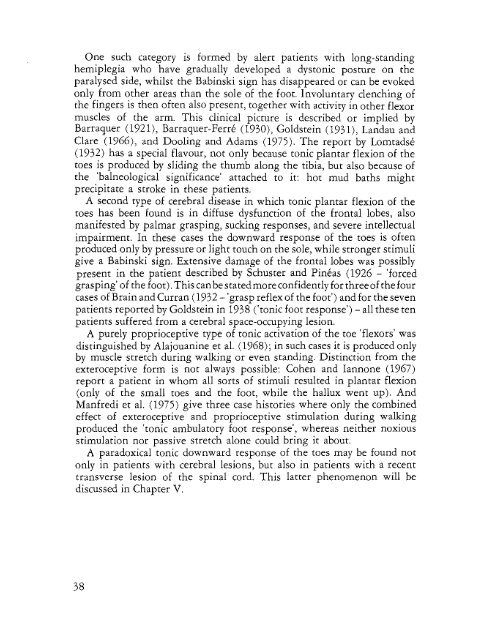You also want an ePaper? Increase the reach of your titles
YUMPU automatically turns print PDFs into web optimized ePapers that Google loves.
One such category is formed by alert patients with long-standing<br />
hemiplegia who have gradually developed a dystonic posture on the<br />
paralysed side, whilst the Babinski sign has disappeared or can be evoked<br />
only from other areas than the sole of the foot. Involuntary clenching of<br />
the fingers is then often also present, together with activity in other flexor<br />
muscles of the arm. This clinical picture is described or implied by<br />
Barraquer (1921), Barraquer-Ferre (1930), Goldstein (1931), Landau and<br />
Clare (1966), and Dooling and Adams (1975 ). The report by Lomtadse<br />
( 1932) has a special flavour, not only because tonic plantar flexion of the<br />
toes is produced by sliding the thumb along the tibia, but also because of<br />
the 'balneological significance' attached to it: hot mud baths might<br />
precipitate a stroke in these patients.<br />
A second type of cerebral disease in which tonic plantar flexion of the<br />
toes has been found is in diffuse dysfunction of the frontal lobes, also<br />
manifested by palmar grasping, sucking responses, and severe intellectual<br />
impairment. In these cases the downward response of the toes is often<br />
produced only by pressure or light touch on the sole, while stronger stimuli<br />
give a Babinski sign. Extensive damage of the frontal lobes was possibly<br />
present in the patient described by Schuster and Pineas (1926 - 'forced<br />
grasping' of rhe foot). This can be stated more confidently for three of the four<br />
cases of Brain and Curran ( 1932- 'grasp reflex of the foot') and for the seven<br />
patients reported by Goldstein in 1938 ('tonic foot response')- all these ten<br />
patients suffered from a cerebral space-occupying lesion.<br />
A purely proprioceptive type of tonic activation of the toe 'flexors' was<br />
distinguished by Alajouanine eta!. (1968); in such cases it is produced only<br />
by muscle stretch during walking or even standing. Distinction from the<br />
exteroceptive form is not always possible: Cohen and Iannone ( 1967)<br />
report a patient in whom all sorts of stimuli resulted in plantar flexion<br />
(only of the small roes and the foot, while the hallux went up). And<br />
Manfredi eta!. (1975) give three case histories where only the combined<br />
effect of exteroceptive and proprioceptive stimulation during walking<br />
produced the 'tonic ambulatory foot response', whereas neither noxious<br />
stimulation nor passive stretch alone could bring it about.<br />
A paradoxical tonic downward response of the toes may be found not<br />
only in patients with cerebral lesions, but also in patients with a recent<br />
transverse lesion of the spinal cord. This latter phenomenon will be<br />
discussed in Chapter V.<br />
38
















